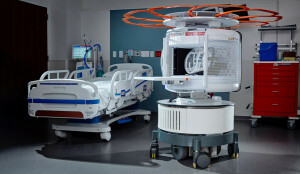by
John R. Fischer, Senior Reporter | February 16, 2022

Demand for mobile medical imaging is on the rise, according to Frost & Sullivan
Demand for mobile medical imaging is on the rise as providers seek out cost-effective solutions that they can move among and use in different clinical settings.
Using advanced image processing and noise cancellation, these solutions can produce quality images for accurate diagnoses and are available for a range of modalities, from MR to X-ray to ultrasound. They are portable, more accessible for patients and steadily growing in popularity due to the rising prevalence of chronic diseases that require monitoring and the number of mobility restricted, aged patients.
Even the COVID-19 pandemic has increased their appeal, with providers looking for point-of-care systems that could reduce exposure and spreading of the virus, according to Frost & Sullivan’s most recent analysis, Global Mobile Medical Imaging Technology Innovations and Growth Opportunities.



Ad Statistics
Times Displayed: 135831
Times Visited: 7850 MIT labs, experts in Multi-Vendor component level repair of: MRI Coils, RF amplifiers, Gradient Amplifiers Contrast Media Injectors. System repairs, sub-assembly repairs, component level repairs, refurbish/calibrate. info@mitlabsusa.com/+1 (305) 470-8013
"These portable imaging systems were used at the frontlines of care for detecting the extent of COVID-19-associated lung infection through chest imaging of the patients. The recognition of mobile medical imaging systems as lifesaving diagnostic tools for evaluation and triaging of patients with potentially life-threatening conditions including pneumothorax and dyspnea during the ongoing pandemic by the World Health Organization (WHO) and the American Society of Echocardiography(ASE) has contributed to their rapid adoption across health facilities in the past two years," Neeraj Nitin Jadhav, TechVision research analyst at Frost & Sullivan, told HCB News.
Whereas fixed systems require a dedicated and specialized room, mobile imaging devices consist of components that have been reduced in size and are designed to be compact, lightweight and portable. They do not require days for installation, can image patients at hospital bedsides or in the comfort of their homes, and have minimal setup that is less likely to disrupt patient services. Portable MR, for instance, has been found to
reduce risks and complications associated with stroke and can be useful in settings where access to fixed solutions is limited.
They also can prevent having to transport critically ill patients from hospitals to radiology imaging diagnostic centers and the complications associated with it. Additionally, mobile medical imaging is safe and comes with a lower cost of ownership that has made it popular among nursing homes, urgent care centers, physician offices and patients’ homes.

